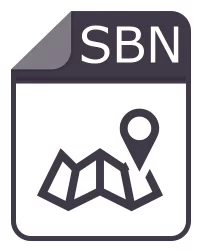SBN (Spatial Binary Index File)
GISBox is a one-stop 3D GIS data editing, conversion and publishing platform that supports editing in multiple GIS formats such as OSGB/GEOTIFF/RVT, converting to 3DTiles/Terrain and publishing.
Introduction
SBN files are spatial data index files used in ArcGIS software by Esri and exist as part of SHP files (Shapefiles). SBN files mainly store spatial index information and play a role in accelerating the spatial query and display speed of Shapefiles.

File Structure
SBN files are stored in binary format and contain spatial index information. The index is mainly composed of the following elements:
- Spatial boundary information: record the minimum bounding box (MBR) of the data.
- Spatial segmentation information: divide the spatial data into a grid and manage the geometric information contained in each cell.
- Reference pointer: store pointers to geometric data to achieve fast reference to the index.
SBN files use the R-tree spatial index algorithm to efficiently retrieve geometric information in Shapefile. R-tree performs well in high-speed queries of multidimensional spatial data and can significantly improve the processing efficiency of large geographic data.
Pros
- Fast spatial query: SBN files provide spatial indexes, which significantly speed up spatial query and display processing. For example, for Shapefiles containing millions of points or polygon data, query processing can be performed smoothly after using SBN indexes.
- Efficient data visualization: When displaying large-scale geographic data in GIS software, SBN files can speed up rendering and reduce latency.
- Small file size: SBN files only store spatial index information, are small in size, and take up almost no disk space.
- Automatic generation and easy management: In software such as ArcGIS, SBN files are automatically generated when creating indexes for Shapefiles, without the need for manual management by users, and are easy to operate.
Cons
- Esri proprietary format, low versatility: SBN files are only supported in Esri products such as ArcGIS, and other GIS software (such as QGIS, MapInfo) are usually unable to read, resulting in poor compatibility between software.
- Uneditable: SBN files are stored in binary format and cannot be edited directly. If you need to modify the index, you must regenerate it based on the original Shapefile.
- Need to regenerate the index: After the Shapefile data is edited, the SBN file will become invalid, so the index needs to be regenerated after editing.
Application Scenario
In urban planning and environmental management, millions of geographic data need to be processed. When displaying and analyzing these large-scale data, the spatial index of SBN files can achieve high-speed query and smooth display. In disaster management and environmental monitoring, such as real-time visualization and analysis of large-scale spatial data such as floods, earthquakes and forest fires, SBN files can accelerate spatial query and improve data processing efficiency. SBN files also play a role in scenarios such as cadastral management and real estate appraisal. When faced with large-scale Shapefile data containing real estate or land information, SBN indexes can speed up queries and make geographic data processing more efficient.
Example
- Example of a SBN file.

- Open the SBN file in the software.

File Opening Mode
- SBN file opened in ArcMap.
